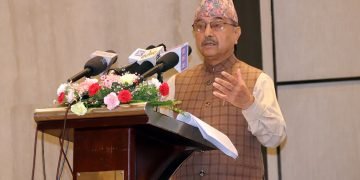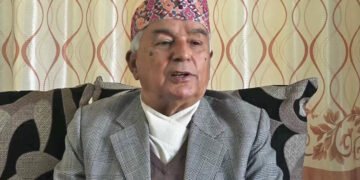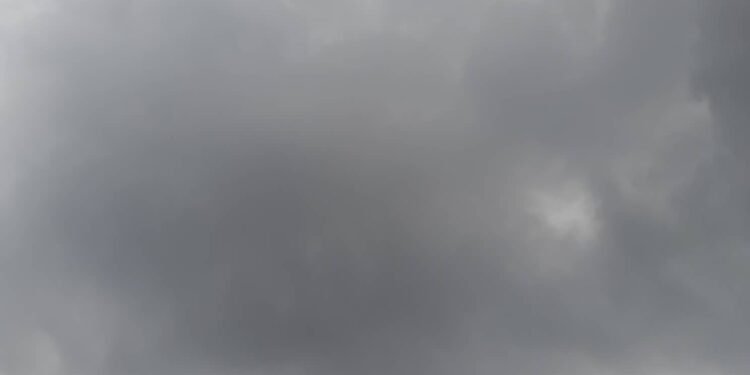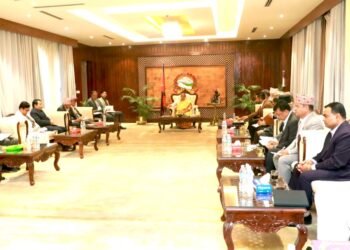Kathmandu, April 5: The Kathmandu Valley has been clogged up with air pollution for some days. People here are desperately waiting for the exit of the nasty smog.
The valley dwellers have no solution either in hand but to remain in jitter, for there are no noticeable initiatives to fizzle out the smog except circulars from government agencies and the warning from medical practitioners. The valley denizens are appealed to not leave home except for essential works so that they could avoid the chilling effect of air pollution.
Indeed, the data shared by the Air Quality Index (AQI) showed that Nepal became the most polluted city till Thursday afternoon. The air pollution notched 348 AQI. Once the pollution rises above 301AQI, it is considered extremely unhealthy.
The environmentalists and medical doctors alike requested for adopting caution. Deputy Prime Minister and Minister for Urban Management, Prakash Man Singh, also held a discussion on Thursday how the pollution could be curbed.
The Ministry of Health and Population issued a notice and urged everyone to adopt high precaution, indicating dreadful level of air pollution.
Ministry spokesperson Dr Prakash Budhathoki suggested special caution, alerting over the possibility of lung disease including asthma, eye problems, skin allergy, heart disease and other acute health risks. The children, pregnant and people with chronic diseases would be further vulnerable, he added.
Question arises: How did such extreme weather event befall Kathmandu Valley? Climatologist and disaster management expert Dr Dharma Raj Uprety informed that the westerly wind was weak, failing to bring rains and no wind blowing to sweep away the dirty air. It has resulted in the nasty smog deposit in the bowl-shaped valley, according to him.
“At present, temperature is rising; forest fires are growing; and agricultural crop residues are burnt, thereby adding smoke in the air,” he said, reminding that the climate change has further impacted on the weather patterns to worsen the condition. The absence of rainfall triggers the air pollution, Uprety argued.
Meteorologist at Weather Forecasting Division, Pratibha Manandhar, also said though the air quality may improve slightly in some days, the wind capable to seep away the polluted air is not in sight.
Similarly, Director General at Environment Department, Gyanraj Subedi, shared observation that Nepal has been witnessing reduced winter rains for four years, while lack of adequate rains despite pre-monsoon, increasing forest fires and dearth of environment-friendly infrastructures were aggravating air pollution.
“The dirty air is standing in the bowl-shaped Kathmandu Valley. Unless there is rain or heavy wind, the dust particles in the polluted air do not sink onto the surface,” he explained.
The Environment Department has warned of high level of air pollution till mid-June and urged everyone to adopt utmost alertness.
As the officials and experts said, the data showed that last Wednesday alone there were 253 wildfires reported across the country. As many as 45 districts saw the forest fires.
Pollution takes a toll on health
In this connection, a cardiologist Dr Ranjit Sharma said the people with heart diseases are most vulnerable at such hostile weather. He strongly suggests everyone to use masks and not to leave home only except urgency. “Pollution is so high at morning that those suffering from chronic health problems like that of heart disease must not go morning walk,” he stressed. High alertness is equally necessary for those with respiratory problem, cardiac ailment, diabetes, and high cholesterol.
Ophthalmologist Dr Muna Kunwar also warned of eye problems including conjunctivitis, dryness and swelling of eye due to dirty air.
Even the dermatologists have similar suggestion to avoid contact with polluted air- stay at home.
Gynecologist and obstetrician at Civil Hospital, Dr Jitentra Pariyar, argued the pregnant women suffer most at such adverse weather. “Government must devise a policy to reduce pollution and enforce it effectively,” he suggested.
Health emergency suggested
Another expert on environment Bhusan Tuladhar underlined the urgency of declaring a health emergency along with massive public awareness because AQI went beyond 300 in Kathmandu Valley.
As experts warn and suggest the government over impact of air pollution, the rights defenders also argue that it is sheer violation of human rights because Nepal’s constitution has guaranteed right to clean environment as a fundamental right.
“Currently, people are deprived of their right to live in a clean environment,” commented, Prakash Mani Sharma, senior advocate and expert on environment.
Air Quality Management Work Plan for the Kathmandu Valley, 2076 has the provision that once the air quality crosses the notch of AQI 300, it is regarded as a disaster.
The Environment Department has, however, admitted that those polluting environment could not be brought to book despite repeated warning and direction to reduce pollution.





















